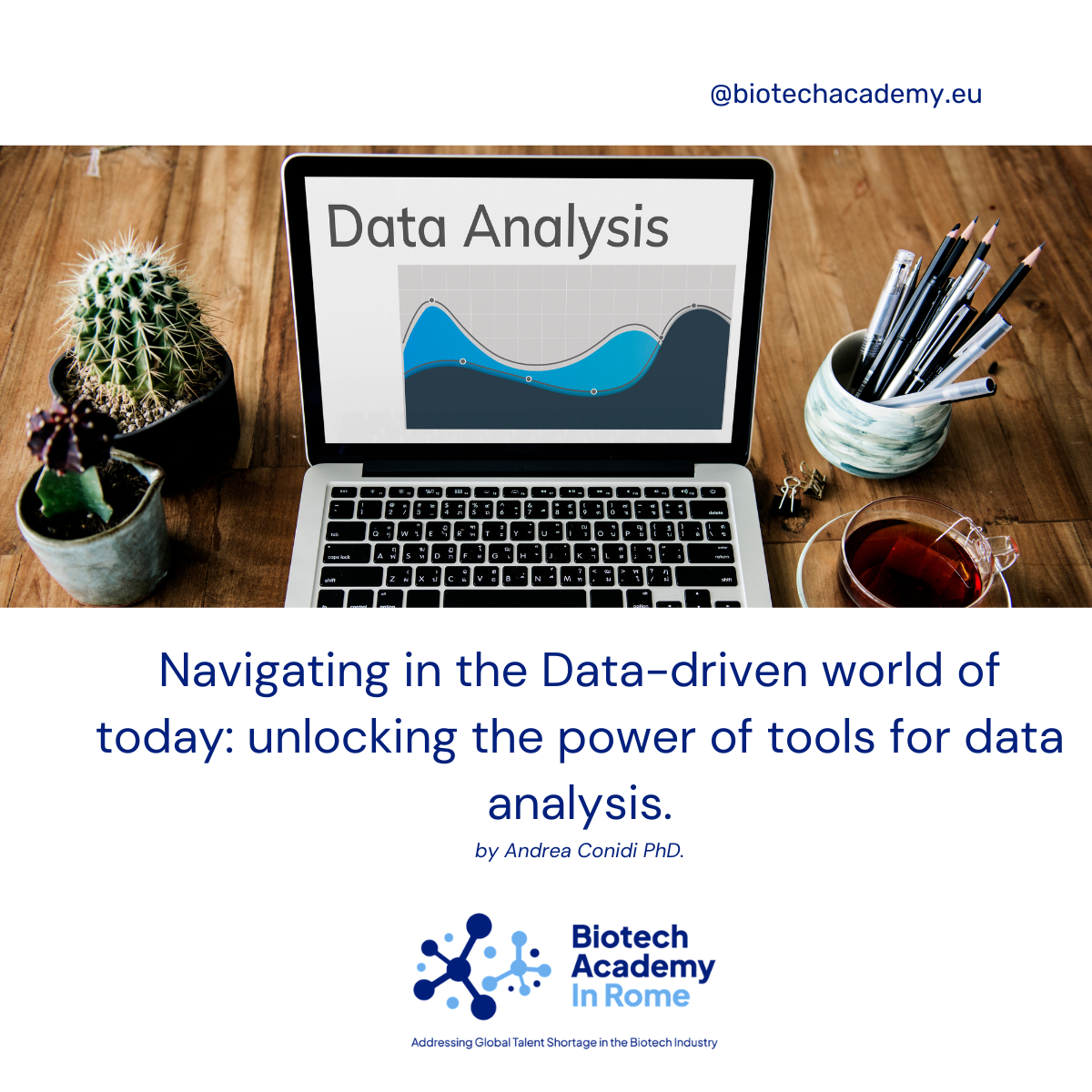
Navigating in the Data-driven world of today: unlocking the power of tools for data analysis.
Andrea Conidi, PhD, Expert in functional “omics” Data Analysis.
In our contemporary landscape, the world is undergoing a radical transformation fueled by the exponential growth and availability of data. In every sector, from finance to healthcare, from manufacturing to biopharma, the ability to extract valuable insights from vast datasets has become a critical determinant of success. The shift towards a data-driven paradigm underscores the indispensable role of data science in planning business and research strategies.
Data science is the approach to unravel patterns, trends and correlations within massive datasets that might be otherwise overlooked. In a world inundated with information the ability to extract meaningful insights allows organizations to make informed decisions, optimize processes and identify new opportunities for growth, while at the same time reducing risks. Companies that embrace data science find themselves at the forefront of progress, constantly pushing boundaries and redefining what is possible.
The biopharmaceutical market is a clear example of a sector where data is central. The availability of big “Omics” datasets (Next Generation sequencing, proteomics, metabolomics, functional genomics) has pushed for the development of analysis tools to accelerate research, development and innovation. As the industry evolves, the extensive use of programming languages, such as R and Python, to extract data insights and develop new strategies has become crucial in such competitive market.
R is a statistical programming environment explicitly designed for data analysis and visualization. Developed by statisticians, R excels in statistical computing, making it a preferred choice for researchers in fields such as bioscience, biostatistics, epidemiology and social sciences. Its ease of use and its intuitive syntax make R as an ideal tool to start analyzing, visualizing and present research data without too much effort. Nowadays many packages are available to perform routine analysis of, for example, RNA-sequencing (both at bulk and single-cell level) or genomic-data.
Python, while excelling in data science, is a general-purpose language that extend beyond statistical analysis. Its versatility makes it suitable for a broader range of applications from web-development to automation and artificial intelligence.
Both R and Python have robust helpful and friendly communities, with R being more focused and aimed to researchers and statisticians including those with no or basic programming knowledge. Python’s community is, on the other hand, composed of a larger and more diverse base. Choosing between the two languages might be confusing, especially for those who approach this world for the first time and it really depends on the needs.
In general, harnessing one or both programming languages is nowadays a requirement in the biopharmaceutical market for many aspects:
- Informed Data-Driven Decisions: From clinical trial to genomic data, R and Python empower researches to gather meaningful insights, allowing informed decision-making at every stage of targets identifications or drug development process.
- Streamlining Research and Development: The complexity of biopharma R&D demands efficient and scalable solutions. Python, with its versatility, and R, with its statistical prowess, offer a powerful combination. Researchers can develop and implement algorithms, models and simulations accelerating the discovery of novel drugs, optimizing experimental design and shortening development timelines.
- Enhanced Collaboration and Reproducibility: The collaborative nature of biopharmaceutical research emphasizes the need for transparent and reproducible workflows. R and Python provide robust frameworks for creating shareable scripts and pipelines, not only advancing collaborations but also ensuring that analyses can be replicated and validated, promoting the reliability of the findings.
- Customization and Scalability: Biopharma projects often demand tailor-made solutions to address unique challenges. Both R and Python excel in providing scalable and customizable solutions with scripts and visualization tools allowing for flexibility and adaptability to specific project requirements.
- Integration with Advanced Technologies: The integration of R and Python with emerging technologies such as artificial intelligence and machine learning has revolutionized the biopharmaceutical landscape. These languages enable the development of predictive models, pattern recognition and advanced algorithms offering unprecedented insights into protein modelling, disease mechanisms and drug development.
As the demand for data-driven insights and technological advancements in biopharma grows, so does the need for professionals with expertise in R and Python. Research organizations (academic and private sectors) actively seeks individuals proficient in these two programming languages to handle big complex datasets and extract as much information as possible.
In conclusion, as our world becomes more and more interconnected and data-oriented, the role of data science becomes increasingly necessary: from shaping business strategies to driving innovation and decision-making. In this data-driven world, the ability to harness the power of data with programming languages as R and Python, is no longer just an advantage but a strategic requisite for those seeking to thrive in their respective fields.
We suggest: Introduction to R – Biotech Academy in Rome






